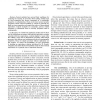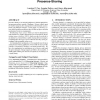30 search results - page 4 / 6 » Analyzing Privacy in Enterprise Packet Trace Anonymization |
CSFW
2009
IEEE
14 years 16 days ago
2009
IEEE
—Formal methods have proved their usefulness for analyzing the security of protocols. Most existing results focus on trace properties like secrecy (expressed as a reachability pr...
SIGCOMM
2010
ACM
13 years 6 months ago
2010
ACM
IP traceback can be used to find the origin of anonymous traffic; however, Internet-scale IP traceback systems have not been deployed due to a need for cooperation between Interne...
USENIX
2000
13 years 7 months ago
2000
This paper presents Pandora, a network monitoring platform that captures packets using purely passive techniques. Pandora addresses current needs for improving Internet middleware...
MOBISYS
2007
ACM
14 years 5 months ago
2007
ACM
Presence-sharing is an emerging platform for mobile applications, but presence-privacy remains a challenge. Privacy controls must be flexible enough to allow sharing between both ...
CCS
2008
ACM
13 years 7 months ago
2008
ACM
Network operators are reluctant to share traffic data due to security and privacy concerns. Consequently, there is a lack of publicly available traces for validating and generaliz...


